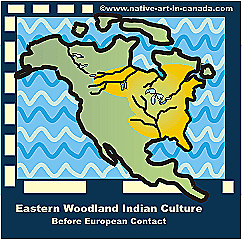The Woodland Indians Culture (original) (raw)
Native-Art-in-Canada has affiliate relationships with some businesses and may receive a commission if readers choose to make a purchase.
- Home
- Woodland Indians
Overview of the Eastern Woodland Indians' Culture

Eastern Woodland Indians is a term coined by twentieth century anthropologists and happily picked up by school boards attempting to simplify a program of native studies.
The term describes a polygot of tribal societies that once inhabited an area in North America that extended from the northern coniferous tree line and the headwaters of the McKenzie River, through the vast boreal forests surrounding the Great Lakes and the shores of the Mississippi River, south to the Gulf of Mexico and east through the Carolina forests to the Atlantic seaboard.
The Woodland culture developed over time, but became cohesive approximately 3000 years ago. Depite the difficulties with transportation and communication over such a vast area, the glue that held it all together was dodem...the clan system of governance. There were seven matrilineal clans and membership in one clan or another was universal across the vast Eastern Woodland Indian territory. Each clan had a specific responsibility to the welfare of the society as a whole.
European ears heard "totem" and for hundreds of years have made up silly stories about what the word meant.
When First Nations people were forced onto reservations dodem almost became extinct...the exceptions being in one or two remote areas of Canada where people were not living under the control of Indian Affairs and governed themselves and where they were also able to resist the influence of mainstream religion. Recently, under the direction of elders, young men and women on at least one Canadian reservation have begun the process of educating their community members in how dodem might eventually replace the imposed band council.
Eastern Woodland Indians Subcultures
In the sense that all Woodland First Nations were living in heavily forested areas, many aspects of the cultures of the various Eastern Woodland Indians were similar. The development of thick walled pottery that was widely distributed throughout many parts of the territory, especially below the Great Lakes, for example.
But look carefully at the map at the top of the page and notice that the territory extended thousands of miles.
Despite the fact that dodem was the universal system of governance, differences in climate and the restrictions imposed by the transportation and communication systems available in such a huge territory, meant that there were differences in social and political structures, religious beliefs and language.
Variations in temperature and terrain from one end of the region to another meant that there were significant differences in types of housing, food resources and clothing.
At the time of European contact, there were three large sub-groups of Woodland Indians that could be divided geographically (north, northeastern and southeastern) and very roughly into three language families...Algonquian, Iroquoian and Muskogean.
If you follow the links below you'll notice that there are differences in culture between the Eastern Woodland Indians who lived in the north, those who lived in the middle of the continent and those who lived in the more temperate south.

Eastern Woodland Indians - Above the Great Lakes
At the time Europeans reached the shores of North America, the Ojibwa Indians were the largest tribe on the continent. They referred to themselves as Anishnabe - a word that means the people.
Eastern Woodland Culture Below the Great Lakes
There were many similarities between the Eastern Woodland Indians who lived below the Great Lakes and their cousins who lived in the rocky forests of the Laurentian Shield.
Eastern Woodland Culture in the Southeast
Although the Eastern Woodlands Indians culture reached as far north as the headwaters of the McKenzie River in what is now Canada, it thrived particularly well in the forests and fertile soil along the Ohio River and south along the Mississippi to the Gulf of Mexico. The map shows the most southerly range of the Woodland way of life.
The Mound Builders is a term used to describe several First Nation's cultures that built earthen burial mounds and other earthworks across a large area of North America that extended from the Great Lakes to the Gulf of Mexico and from the Mississippi and Missouri Rivers to the Appalachian mountains. The Mound culture emerged at about 3000 BC and disappeared around 1200 AD.
An elder's look at Ojibwa history from the time just before European contact to the present.
Woodland Culture Just 70 Years Ago
An Ojibwa elder, Nokomis, lived a traditional life in the bush north of Lake Superior and tells stories about that time.
